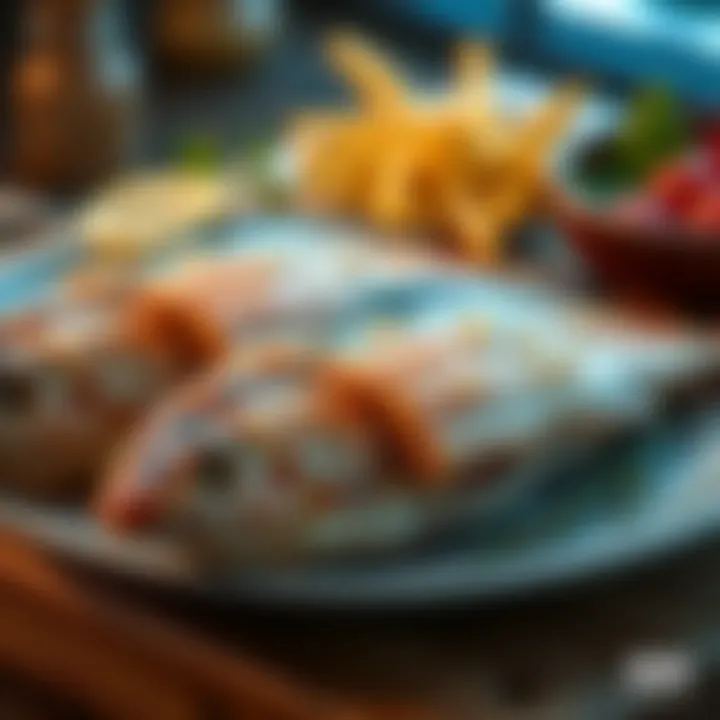Aldi's Frozen Fish: Nutrition, Cooking & More


Intro
In the ever-expanding universe of grocery options, Aldi stands out as a prominent player, especially when it comes to its frozen fish selection. This topic deserves attention because of the increasing emphasis on health-conscious eating and culinary experimentation among consumers. Frozen fish isn’t just a convenience food; it's a treasure trove of nutritional benefits and culinary versatility. Yet, many shoppers remain unaware of what Aldi has to offer in this realm.
In this guide, we take a close look at the frozen fish options stocked at Aldi. From the catch of the day to the frozen fillets in neat packaging, there's much more to explore than just the price tag. We'll unpack nutritional aspects, sourcing practices, and the various methods to prepare these ocean-dwelling choices, ensuring you make informed decisions that pair well with your dietary needs.
Recipe Overview
When it comes to cooking frozen fish, there are numerous delightful dishes that can be both quick to prepare and high on flavor. One notable dish to highlight could be Crispy Baked Cod Tacos. These tacos exemplify how frozen fish can transform a simple meal into something extraordinary.
Brief Description of the Dish
These tacos feature flaky cod wrapped in a golden, crispy shell and are topped with a medley of fresh ingredients like cabbage and salsa, harmonizing textures and flavors beautifully. With ease of preparation, they are perfect for a busy weeknight or laid-back weekend gatherings.
Key Ingredients
- Frozen Cod Fillets (available in various styles such as battered)
- Taco Shells (soft or hard)
- Shredded Cabbage
- Fresh Salsa
- Lime Wedges
- Avocado (optional)
- Spices (like cumin and paprika)
Preparation Guidelines
Step-by-Step Instructions
- Preheat your oven according to the instructions provided on the frozen cod packaging. Aim for around 450°F (232°C).
- Arrange the frozen cod fillets on a baking tray lined with parchment paper or a non-stick baking mat.
- Sprinkle spices over the fish to add extra flavor, depending on your preference.
- Bake for about 15-20 minutes or until the fish is golden brown and flakes easily with a fork.
- While the fish cooks, warm your taco shells in the oven for the last few minutes as well.
- Assemble your tacos by placing a piece of cod in the shell, topping with shredded cabbage, and drizzling salsa.
- Serve immediately, garnished with lime wedges and avocado, if you're feeling fancy.
Preparation Tips and Tricks
- Make sure to let the fish thaw a little if you prefer a juicier texture.
- Don't shy away from experimenting with your own spices or marinades to elevate the flavor.
- Focusing on fresh toppings can make a world of difference when it comes to taste.
The ease of preparation and the capability for customization make Aldi's frozen fish an excellent choice for anyone aiming to broaden their culinary horizons. For those who are health conscious, incorporating fish into your meals offers numerous benefits, including lean protein and essential fatty acids.
For more resourceful insights on nutrition and the benefits of incorporating fish into your diet, you might find information at Health.gov or engaging discussions on platforms like Reddit.
Aldi’s commitment to quality in their frozen fish selection not only makes it easier to enjoy meals but also aligns with growing sustainable practices in sourcing seafood. By choosing Aldi's offerings, savvy shoppers are not just feeding their families but also embracing a healthier lifestyle.
Preface to Aldi Frozen Fish
Aldi has carved a niche for itself in the grocery sector, particularly with its selection of frozen fish products. This is not just any convenience food; it represents a blend of quality, affordability, and variety. The importance of these frozen fish offerings resonates deeply, catering not only to health-conscious shoppers but also to culinary enthusiasts looking to elevate their cooking.
From busy weeknight dinners to more elaborate weekend meals, Aldi's frozen fish can simplify meal prep without sacrificing taste or nutrition. The key elements to consider when exploring this category include:
- Nutritional value: Frozen fish retains much of its original nutrients. Aldi provides details on calorie counts and macronutrients, enabling consumers to make informed dietary choices.
- Flavor diversity: With options ranging from salmon to various white fish, the choices are as important as their nutritional benefits. Each type has its unique taste profile and cooking methods.
- Convenience and sustainability: Many people today aim to incorporate more seafood into their diets. Frozen fish can sometimes be a hassle-free, environmentally friendly choice compared to fresh fish, which requires more careful sourcing.
"Eating fish is like taking a walk on the wild side without stepping out of your house."
With Aldi's commitment to sustainability, shoppers can feel confident their choices align with environmental considerations. They offer an impressive array of options, satisfying varying taste preferences and dietary requirements, including gluten-free or low-fat diets.
In summary, the frozen fish selection at Aldi is not just a way to put food on the table. It's a medium through which we can appreciate the benefits of seafood, embrace culinary creativity, and contribute to sustainability. This article aims to guide readers through the myriad choices, ensuring a richer understanding of what Aldi has to offer in the frozen fish department.
Nutritional Profile of Aldi Frozen Fish
Understanding the nutritional profile of Aldi's frozen fish is crucial for anyone looking to improve their dietary habits. Fish is not just a source of protein, it also delivers a wealth of nutrients that can benefit overall health. What makes frozen fish particularly appealing is the convenience it offers while still maintaining essential nutritional qualities. This section tackles the key components of Aldi's frozen fish, from caloric content and macronutrients to vitamins and minerals, ultimately highlighting the health benefits associated with these products.
Caloric Content and Macronutrients
When considering frozen fish, the caloric content can significantly vary depending on the type of fish selected. As a rule of thumb, fatty fish like salmon are higher in calories due to their natural oils, while leaner options such as cod present a lower caloric count. For example, a standard serving of frozen salmon from Aldi typically contains around 200 calories, providing essential fats, while a portion of frozen cod may clock in at about 90 calories.
In terms of macronutrients, fish is an impressive source of complete protein, which aids in maintaining muscle mass. A single serving of salmon may offer around 22 grams of protein alongside healthy omega-3 fatty acids, known for their heart-protecting qualities. Comparatively, lean white fish like haddock provides approximately 20 grams of protein per serving with minimal fats, making it an excellent choice for those watching their fat intake. Hence, whether seeking heft in your diet or a lighter option, Aldi's frozen fish range allows a flexible approach to meal planning.
Vitamins and Minerals
Frozen fish doesn't just contribute macronutrients; it's a powerhouse of vitamins and minerals as well. Rich in B vitamins, particularly B12, consuming fish supports nerve health and energy production. Aldi’s frozen fish selection offers a balance of these critical nutrients, essential for those on plant-based diets where higher B12 intake could be challenging.
Moreover, frozen fish provides significant amounts of selenium, a mineral that plays a key role in antioxidant defense and thyroid function. Regular integration of these products into your meals can aid in meeting daily recommended values of essential nutrients. The fact that these fish are available frozen also means they retain their nutrient profile, emphasizing the utility of Aldi in making healthy choices convenient.
Health Benefits
The health benefits of including Aldi's frozen fish in your diet cannot be overstated. Regular consumption of fish has been linked to a reduced risk of cardiovascular diseases, owing mostly to those omega-3 fatty acids. Furthermore, studies suggest that diets rich in fish may improve brain health, potentially reducing the risk of cognitive decline.
Another noteworthy aspect is the role of fish in weight management. Due to their high protein and low carbohydrate content, meals made with frozen fish can lead to enhanced satiety, making it less likely for individuals to overeat. Therefore, having these products on hand can serve multiple dietary goals, from weight loss to maintaining overall wellness.
"A well-balanced diet revolving around frozen fish not only nourishes the body, but also contributes to long-term health outcomes."
In summary, the nutritional profile of Aldi's frozen fish is diverse and rich in key components necessary for a balanced diet. Their frozen options help alleviate common barriers that may deter individuals from consuming fish regularly, making healthy eating accessible to a wider audience.
Types of Frozen Fish Available at Aldi
The availability of various types of frozen fish is essential in making Aldi a go-to option for seafood lovers. Shoppers can easily find a mix of flavors and textures to suit their palate. Plus, with an emphasis on quality and affordability, Aldi's fish selection caters to different culinary needs while promoting a healthy diet. In this section, we will delve into the different types of frozen fish available, discussing the unique attributes and benefits of each category.
Salmon Varieties
Salmon is a beloved choice among seafood enthusiasts, priding itself on its robust flavor and numerous health benefits. At Aldi, you’ll find several salmon options, including wild-caught and farmed varieties. Each type carries its own merits. Wild-caught salmon tends to be richer in omega-3 fatty acids due to its natural diet, making it a popular pick for health-conscious consumers. Farmed salmon, while still nutritious, may have a milder flavor and lesser omega-3 content.
When purchasing salmon at Aldi, it’s often packaged in convenient portions, making meal preparation straightforward. Some salmon options come pre-seasoned or flavored, which is great for those nights when speed is of the essence. To prepare, you can bake, grill, or even pan-sear the fillet, pulling out the delicious flavors with minimal effort.
White Fish Selections
Aldi doesn't stop at salmon; it also boasts a variety of white fish options, including cod, tilapia, and haddock. These fish offer a delicate flavor and are lower in fat, appealing to someone looking to watch their caloric intake. White fish is incredibly versatile, holding up well in various cooking methods. Whether you prefer something light and flaky or a firmer texture, there is likely a white fish at Aldi that fits the bill.
Among these selections, cod is particularly noteworthy. Known for its mild flavor and firm texture, it is great for preparing fish and chips, tacos, or even baked dishes. Tilapia, another popular option, is easy on the wallet and can quickly absorb spices and marinades, bringing zest to any meal.
When choosing white fish, look for fillets that are moist but not slimy and have a clean, ocean-fresh smell to ensure quality.


Shellfish Options
For those who enjoy the briny satisfaction of shellfish, Aldi offers a diverse range that includes shrimp, scallops, and even mussels. These options are full of texture and can bring a touch of sophistication to weeknight dinners without breaking the bank. Shellfish is also a fantastic source of protein and can be a welcome boost for anyone looking to diversify their diet.
Shrimp, for example, is available in different sizes and preparations—peeled, deveined, and even cooked. It’s a crowd favorite for quick meals, as it cooks in just a few minutes. Scallops, with their sweet flavor and tender texture, elevate dishes effortlessly; they work wonderfully seared or baked. Mussels can be an adventurous choice, providing a unique flavor and can be steamed and enjoyed with a variety of sauces.
Sourcing and Sustainability Practices
In today's world, the sustainability of our food sources is more critical than ever. The sourcing and sustainability practices of frozen fish products are key areas where consumers can have a lasting impact both on the environment and on global fish populations. By understanding how and where products are sourced, shoppers can make informed choices that contribute to the preservation of aquatic ecosystems while still enjoying the convenience and nutritional benefits associated with frozen fish.
Sourcing Standards
Aldi is committed to ensuring that its frozen fish selections adhere to stringent sourcing standards. This not only means aiming for high-quality fish but also ensuring that fish are caught or farmed in ways that support the fish populations and the ecosystems they inhabit. Aldi collaborates with various organizations, such as the Marine Stewardship Council (MSC) and the Aquaculture Stewardship Council (ASC), to ensure responsible sourcing practices.
These certifications indicate that the fish has been sourced from fisheries that prioritize environmental health and ethical practices. Shoppers can look for these labels on the packaging, providing an extra layer of assurance about the sustainability of the product they choose.
Moreover, Aldi prioritizes transparency in its supply chain, allowing customers to trace the origins of their fish. This level of accountability is crucial, as it not only provides confidence to the consumer but encourages sustainable fishing practices industry-wide.
Impact on Fisheries
The impact of sourcing practices on fisheries can be profound. Unsustainable fishing methods can lead to overfishing, which threatens not only the fish species targeted but also entire marine ecosystems. By supporting brands that prioritize sustainable sourcing, consumers play a role in promoting practices that protect fish populations and their habitats.
- Reduced Overfishing: The sourcing standards help to mitigate the effects of overfishing. Sustainable practices ensure that fish populations have the time to recover and regenerate.
- Habitat Protection: Ethical sourcing also emphasizes the importance of preserving marine habitats which are increasingly under threat from destructive fishing practices.
- Social Responsibility: When consumers choose sustainably sourced options, it often promotes fair labor practices, benefiting communities reliant on fishing for their livelihoods.
"Choosing sustainable fish means you are not just feeding yourself but also contributing to a healthier planet for future generations."
Cooking Methods for Aldi's Frozen Fish
When it comes to preparing frozen fish from Aldi, the cooking methods you choose can make a significant difference. Selection of the right technique isn’t just about flavor; it also impacts nutritional value and texture. With a handful of foolproof methods now at your disposal, you can easily transform these frozen fillets into gourmet meals. Different methods have unique benefits, so understanding these options will not only enhance your cooking skills but also give your meals a delicious edge.
Baking Techniques
Baking is one of the simplest and most effective ways to cook frozen fish. By using this method, you can enjoy a meal that stays both healthy and flavorful. The key advantage of baking is the ability to maintain the fish’s natural moisture. This often leads to a tender product.
To bake frozen fish, it's generally best to preheat your oven to around 400°F (200°C). Place the fish on a parchment-lined baking tray and sprinkle some salt, pepper, and your favorite seasonings. Bake for about 20-25 minutes, depending on the thickness of the fish. With it, you can add vegetables like asparagus or bell peppers for a complete meal.
Think about this: Baking can be done with minimal fuss, leaving you time to whip up a side salad or prepare a sauce while the fish cooks.
Grilling and Pan-Seering
Grilling or pan-searing are fantastic ways to add a smoky flavor to Aldi's frozen fish. These methods also achieve a crispy exterior while maintaining a moist inside, which many find appealing.
When grilling, preheat your grill to a medium-high temperature. A light brush of olive oil on the fish helps prevent sticking, and you can season it just like you would when baking. Assuming the fillets are thawed, grill them for about 5-7 minutes per side. However, cooking straight from frozen requires a few more minutes.
Pan-searing also works like a charm. Heat a non-stick skillet over medium heat, add a splash of oil, and place the fish directly into the hot skillet. For frozen fillets, it might take around 10-12 minutes in total, flipping halfway through.
To really elevate your dish, consider finishing grilled or pan-seared fish with a squeeze of lemon or a sprinkle of fresh herbs.
Steaming and Microwaving
Lastly, steaming and microwaving are quick and healthy alternatives when you're in a hurry. These methods retain moisture and nutrients effectively, allowing the natural flavors of the fish to shine through.
When opting to steam, place the fish in a steamer basket above simmering water for 6-10 minutes, depending on the thickness. You can add herbs, lemon slices, or garlic for extra flavor.
On the other hand, if you're in a rush, microwaving can do the trick. Place the frozen fish on a microwave-safe plate and cover it with a lid or microwave-safe plastic wrap. Cook on high for 3-5 minutes until opaque and flaky. However, be attentive; microwaves can vary in strength, and overcooking can dry out the fish.
In short, the right cooking method can elevate frozen fish from Aldi into an enjoyable and nourishing meal.
Choosing your preferred cooking method depends on your time constraints and flavor preferences. With the approaches detailed here, it becomes easier to have a healthy, delicious dining experience right from your kitchen.
Flavor Pairings and Culinary Uses
Flavor pairings and culinary uses of frozen fish are essential components to consider because they not only elevate the taste of your meals but also encourage a varied diet. Whether you’re grilling a salmon fillet or baking some cod, the choices you make with herbs, sides, and sauces can bring out the best in your fish selection. This section delves into why understanding these pairings can make your culinary creations more enjoyable and appetizing.
Herbs and Spices
When it comes to enhancing the flavor of frozen fish, herbs and spices are crucial players. A sprinkle of fresh dill can do wonders for a salmon portion, and a dash of paprika might transform tilapia into something extraordinary. Here are some great options to consider:
- Dill and Lemon: For a classic pairing that brings out the freshness of fish.
- Cilantro and Lime: A zesty combination often used in seafood tacos.
- Garlic and Rosemary: Adds a robust flavor that complements heartier varieties like swordfish.
Selecting the right herbs can drastically alter the fish’s profile. Opting for herbs that contrast or complement the natural flavors of the fish — such as sweet basil for halibut or spicy cayenne for shrimp — can help you create dishes that are anything but bland.
Complementary Side Dishes
Adding the right side dishes is as vital as seasoning the fish itself. Health-conscious individuals and culinary enthusiasts alike appreciate well-thought-out accompaniments that not only balance the meal but also retain focus on the fish. Consider these:
- Roasted Vegetables: Zucchini, bell peppers, and asparagus pair nicely with many fish varieties.
- Quinoa or Rice: These grains are excellent bases that soak up flavors beautifully.
- Salads: Fresh greens tossed with a citrus vinaigrette can lighten the main dish.
With Aldi's selection, you can prepare one-pan dinners where fish and sides meet harmoniously, reducing both cleanup time and ensuring flavors meld together beautifully on the plate.
Sauces and Marinades
Innovative sauces and marinades are game changers in the kitchen, particularly when it comes to frozen fish. Marinating fish before cooking not only adds flavor but can also help keep it moist during the cooking process. Here are some standout choices:
- Miso Glaze: A sweet and savory blend that pairs wonderfully with cod and salmon.
- Salsa Verde: This herbaceous sauce can elevate grilled shrimp.
- Teriyaki Sauce: Perfect for giving a sweet, smoky twist to pan-seared fish.
Experimenting with various sauces can help anyone discover new tastes and textures. Consider advocating for a garlic-butter sauce drizzled over grilled prawns or a spicy aioli served alongside baked fish sticks for a delightful pop of flavor.
"Don’t be shy in the kitchen! Flavor experimentation can lead to unexpectedly delicious outcomes, turning weeknight meals into something memorable."
In summary, understanding the nuances of flavor pairings and culinary applications makes dishes with Aldi’s frozen fish not only satisfying but also exciting. Play around with the combinations, and you'll find that the sky's the limit.
Quick Meal Ideas with Frozen Fish


In today’s fast-paced environment, many are seeking convenient yet healthy meal options. Frozen fish presents a prime solution for those looking to whip up quick, nutritious dishes without fussing around in the kitchen for hours. Aldi’s diverse frozen fish selection not only offers a variety of flavors but also simplifies meal preparation. The fast preparation time allows home cooks to enjoy gourmet-quality meals minus the hassle.
When time is of the essence, the ability to harness the versatility and flavors of frozen fish becomes indispensable. Substantial nutritional benefits can be achieved in mere minutes, making it easier for families to gather around the table after long days of work or school. Both culinary novices and seasoned cooks can take advantage of these meal ideas, turning frozen fish into a vibrant centerpiece of any dinner.
One-Pan Dinners
One-pan dinners are the epitome of simplicity, bringing together protein and veggies in a one-stop cooking process. Utilizing Aldi’s frozen fish, such as flavored salmon fillets or breaded cod, creates an effortless dish packed with nutrients. Using a sheet pan, you can toss in your fish, assorted vegetables like bell peppers and zucchini, and drizzle them with olive oil, some herbs, and spices. Set the oven to roast, and you’re in for an easy meal that pulls together in no time, often taking around 20 to 30 minutes from prep to plate.
Here are some ideas for one-pan combinations that work particularly well:
- Salmon with asparagus and cherry tomatoes
- Breaded fish with broccoli and cauliflower
- Tilapia with mixed bell peppers and onions
Cooking this way also means fewer dishes to clean up afterwards. And let’s face it, aren’t we all looking for ways to make life a bit easier?
Fish Tacos and Wraps
Fish tacos are a delightful marriage of flavors and textures, bringing the ocean right to your plate in a fresh, handheld format. With Aldi’s frozen fish, crafting tacos can be done swiftly. Choose a flaky white fish like cod or tilapia and get to frying or baking those fillets. Crisp lettuce, juicy tomatoes, and tangy salsa can elevate your toppings game while providing a dose of crunch.
Assemble your tacos with:
- Flaky fish fillets
- Cabbage slaw for some crunch
- Sliced avocado for creaminess
- A drizzle of lime crema to tie it all together
Moreover, wraps make for an equally satisfying option. By using a tortilla as your base, you can stuff it with your cooked fish, preferred vegetables, hummus, or any dressing of your choice. They not only offer great taste but are also portable, making them perfect for lunches on the go or quick dinners.
"Frozen fish takes the guesswork out of meal prep while delivering taste and nutrition you can rely on."
In essence, whether you are whipping up a one-pan dinner or putting together fish tacos and wraps, quick meal ideas utilizing Aldi's frozen fish selection are not only convenient but also delicious. By allowing creativity to flow, you’ll be prepared for any night when you want good food without the trip to a fancy restaurant.
Considerations for Storage and Shelf Life
Storage and shelf life are crucial factors when it comes to frozen fish. It’s not just about taste; it’s about safety. Keeping fish properly stored can enhance its flavor and preserve its nutritional value. A clear understanding of how to freeze and store Aldi’s frozen fish is essential in ensuring that you get the best out of your meals.
Best Practices for Freezing
Freezing fish might seem straightforward, but a few details can make all the difference. To maximize freshness, here are some tips on the best practices for freezing:
- Temperature Control: Ensure your freezer is set to 0°F (-18°C) or lower. This prevents the growth of bacteria and preserves texture and taste.
- Air Tight Packaging: Remove as much air as possible from the packaging before sealing. Air exposure leads to freezer burn, which can ruin the fish’s taste and texture. Vacuum-sealed bags are preferred, but tightly wrapped plastic wrap or aluminum foil also works.
- Smaller Portions: Consider dividing large quantities into smaller servings. This not only helps in managing portion sizes when cooking but also enables the fish to freeze faster, maintaining quality better.
- Labeling: Don’t skip labeling. Write the date and type of fish on the package. This helps you keep track of how long it’s been stored and ensures you use older fish first.
Following these best practices will keep your fish in top shape, ready for whenever the craving hits.
Recognizing Signs of Spoilage
Knowing how to spot spoiled fish is vital for your health and culinary experience. Though frozen fish can last a long time, it’s essential to recognize the signs of spoilage, especially if it has been in your freezer for a while.
- Foul Odor: Fresh fish has a mild scent, whereas spoiled fish will have a strong, unpleasant odor. If it smells off, trust your instincts and toss it out.
- Discoloration: If you notice any brown or grey patches on the fish, it could indicate freezer burn or spoilage. While minor freezer burn might be cut away, severe discoloration is a reason for concern.
- Texture Changes: Fresh fish should feel firm. If it’s slimy or mushy, it’s likely past its prime.
- Ice Crystals: Excessive ice crystals on the fish imply that it may have thawed and refrozen, affecting its quality. If you see a large amount of ice buildup, consider it a red flag.
Proper storage doesn’t just extend the life of your groceries; it also ensures your meals are safe and enjoyable.
Understanding these critical aspects of storage and shelf life can not only save money but also preserve the delightful flavors of Aldi's frozen fish selection.
Comparative Analysis with Other Frozen Fish Brands
When it comes to frozen fish, not all products are equal. Evaluating Aldi's offerings in comparison to other frozen fish brands is crucial for potential buyers. This section dives into a detailed analysis of Aldi's fish selection against its competitors, focusing on price and quality to help readers make informed purchasing decisions.
Price Point Comparison
Aldi has built a reputation for affordability, and this holds true for their frozen fish offerings. Generally speaking, Aldi's prices have a knack for making even hesitant shoppers feel like they're getting a steal. For instance, a bag of frozen tilapia fillets from Aldi typically ranges around $4.99 to $6.99, easily outshining many other brands, where the same quantity can cost upwards of $8.00 or more.
Consider also the surprising nature finds, like Aldi’s wild-caught salmon. In comparison, its counterparts might present a higher price tag despite offering similar quality. Customers looking for budget-friendly options can feel reassured knowing that they’re still getting something that doesn’t skimp on nutrition or flavor.
Key Takeaways:
- Aldi consistently offers lower prices than most other brands.
- Seasonal offers can further decrease costs during key months.
- Price should be weighed against quality, not just numbers.
Quality Assessments
Price is just half the equation; quality plays an equally important role in the purchasing decision. Aldi has carved out a space for itself by providing fish that is satisfactory in terms of quality. The fish is often sourced from sustainable fisheries, which is a boon for environmentally-conscious consumers. When you bite into a piece of Aldi's frozen cod, for instance, you're not only intending to enjoy a meal but also often supporting better fishing practices.
In contrast, many competing brands may not provide clear information about sourcing or quality. This lack of transparency can be worrisome for buyers concerned about overfishing or the overall wellbeing of the planet’s resources. Not to mention, Aldi's fish products are generally rated favorably by consumers who appreciate taste and texture after preparation.
"Aldi has a knack for striking a balance between price and quality. Customers often find satisfaction in the taste without breaking the bank."
Considerations While Choosing:
- Look for information about sourcing on the packaging; Aldi shines in this area.
- Taste and texture can often give better insight than price alone.
- Customer reviews and ratings can provide a clearer picture of which products live up to expectations.
Analyzing Aldi's frozen fish through this lens of price and quality allows consumers to shop with greater confidence. The findings suggest that Aldi’s frozen fish selection often hits the sweet spot between value and good quality, making it a strong contender in a competitive market.
Customer Reviews and Feedback
Understanding customer reviews and feedback serves as a crucial component when assessing Aldi's frozen fish offerings. Feedback from customers not only sheds light on the quality and taste of the products but also provides insights into overall satisfaction and value for money. Given that frozen fish can vary significantly in flavor, texture, and freshness depending on brand and type, it becomes essential for potential buyers to gather this information prior to making their purchase decisions. This feedback wheels the conversation, presenting real-world comments that amplify the experience of the shopper.
Additionally, comments from regular consumers help prospective buyers to navigate the selections available. They can express preferences for specific species, cooking methods that worked well, or highlight unexpected flavors that paired nicely. Having a collective understanding from those who frequently choose Aldi can enrich readers’ experiences, illuminating not only the product excellence but also possible culinary adventures.
"Personal experiences can illuminate more than nutritional labels ever could."
Examining both positive and negative reviews encapsulates a broader picture that paints what one's experience can be.
Positive Aspects Highlighted
The overwhelming positive remarks about Aldi's frozen fish often focus on aspects such as taste, convenience, and affordability. Many reviewers rave about the fresh taste that seems to transcend the frozen barrier, claiming that flavors remain robust even after cooking. Shoppers frequently appreciate that Aldi's salmon varieties, for instance, hold up well in various recipes, from grilling to baking. Additionally, numerous customers highlight that the fish is easy to work with, making it a hassle-free option for quick dinners.
Moreover, consumers often reference the pricing structure as a primary benefit. The quality of fish provided at a fraction of the price compared to competitors is a selling point that resonates deeply with shoppers. The combination of high quality and reasonable prices reinforces customer loyalty toward Aldi's products.
Key aspects frequently noted in positive reviews include:
- Quality and freshness: Many customers express satisfaction regarding the freshness of the frozen fish, noting that flavors maintain integrity after cooking.
- Versatility: Reviewers appreciate the adaptability of the fish in various dishes, ranging from simple sautéing to gourmet meals.
- Cost-effectiveness: The affordability of Aldi's frozen fish compared to other brands allows customers to indulge without breaking the bank.


Areas for Improvement
Despite the positive aspects, there are constructive criticisms echoed by a faction of consumers. Some individuals express concerns regarding the variability in the quality of fish batches. A few shoppers reported instances of finding fish that didn’t meet their texture expectations or tasted slightly off. This issue can happen with any brand, but taking note of such feedback is vital for continuous improvement.
Additionally, there are mentions of limited selections, particularly when it comes to rarer types of fish. While Aldi boasts a solid variety of popular species, seafood enthusiasts sometimes seek lesser-known or more exotic options, which aren't reliably available. There’s also a call for better labeling regarding sourcing and sustainability practices, as some customers wish to have a clearer insight into these aspects when making their choices.
Feedback regarding areas that may need attention includes:
- Inconsistency: Occasional reports of varying quality can lead to dissatisfaction among some loyal customers.
- Limited Selection: A smaller variety of fish types compared to mainstream competitors leaves room for improvement in offerings.
- Transparency: Enhancing packaging information regarding sourcing could strengthen trust among environmentally-conscious buyers.
Understanding customer feedback in these ways enables a comprehensive appreciation of Aldi's frozen fish offerings, effectively guiding consumers to make informed choices.
Environmental Impact of Frozen Fish Consumption
The consumption of frozen fish is intertwined with various environmental dynamics that merit consideration in today’s ecologically conscious climate. As more consumers reach for frozen fish options, understanding the consequences of these choices is vital. The significance of the environmental impact here is multilayered, involving everything from carbon emissions during transportation to the overall effects on global fish populations.
When we talk about frozen fish, we're not just discussing a convenient grocery item; we're diving into a larger narrative about sustainability and our role as consumers. We face pressing questions: How do our eating habits affect ocean ecosystems? How can we make better choices? This section will unpack these issues and provide insights that not only inform but empower users to choose wisely in their culinary journeys.
Carbon Footprint Considerations
Frozen fish doesn't simply appear on shelves; it travels a circuitous route that begins at sea. The journey may involve fishing vessels, processing plants, and distribution networks. Each step in this supply chain has its own carbon footprint, influenced by fuel consumption, refrigerants, and transportation methods.
- The fishing process itself contributes emissions based on the type of vessel used and the duration of the catch. Larger ships can have considerable fuel needs, while overfishing can degrade marine habitats, making it harder for fish populations to recover.
- After the catch, fish processing plants often depend on electricity derived from fossil fuels. This energy use adds to the carbon emissions associated with bringing frozen fish to your local Aldi.
- Finally, once fish products are packed and shipped, the transport to grocery stores adds yet another layer to the footprint, especially if transported over long distances.
In summary, the carbon emissions linked to frozen fish consumption can be quite significant, but awareness is the first step towards more responsible choices.
Sustainable Fishing Practices
The term sustainable fishing practices encapsulates methods aimed at preserving fish populations and their ecosystems. As consumers, it’s imperative to choose products that are harvested responsibly. Many brands, including those found at Aldi, are increasingly keen to showcase their commitment to sustainability.
Key aspects of sustainable fishing include:
- Catch Limits: Regulated quotas help to avoid overfishing, ensuring that fish populations can replenish.
- Selective Fishing Gear: Utilizing equipment that minimizes bycatch—non-target species caught unintentionally—helps maintain healthy ocean ecosystems.
- Aquaculture: Fish farming presents a viable alternative to wild catch, as long as it’s done in eco-friendly ways that don’t harm the surrounding environment.
- Certification Schemes: Look for labels such as the Marine Stewardship Council (MSC) or the Aquaculture Stewardship Council (ASC). These certifications offer assurances that fish products are sourced from sustainable operations.
A responsible choice of frozen fish supports these practices and encourages further advancements in environmentally friendly methods. By tuning in to the ecological impacts of our fish consumption, we not only contribute to the health of our oceans but also pave the way for a more sustainable food system.
"Understanding the environmental consequence of our food choices is key to fostering sustainability; it’s a journey every conscientious consumer should embrace." – Anonymous
In closing, evaluating the carbon footprint and choosing sustainable practices are vital in shaping the future of our oceans. It takes thoughtfulness from consumers to drive the market in a direction that prioritizes the well-being of our planet while enjoying the delicious offerings that frozen fish has to provide.
Future Trends in Frozen Fish Products
The frozen fish market is witnessing significant shifts as consumer preferences evolve, influenced by factors like health consciousness, sustainability concerns, and innovations in food technology. As people become more discerning about what they put on their plates, understanding these trends offers a roadmap for businesses and shoppers alike. Aldi's frozen fish selection is capturing these movements, making it crucial to delve into what the future holds for these offerings.
Innovations in Preservation Techniques
In recent years, the food industry has seen advancements in preservation techniques that not only extend the shelf life of fish but also maintain its flavor and nutritional value. High-pressure processing (HPP), for instance, is changing the game by eliminating harmful bacteria without compromising on taste.
These methods bring several benefits to the table:
- Enhanced Safety: Advanced preservation techniques significantly reduce the risk of foodborne illness, an essential factor for concerned consumers.
- Quality Maintenance: With approaches like cryogenic freezing, fish can be frozen rapidly, locking in freshness and preventing cellular damage. This results in a texture and flavor profile that rivals fresh offerings.
- Minimized Additives: Many traditional preservation techniques rely on additives to extend shelf life. Modern alternatives aim to keep products as clean as possible, aligning with the growing trend for minimal processing.
"With HPP and cryogenic freezing, Aldi aims to provide freshness akin to that of a fish market, all while ensuring safety and nutritional integrity."
Incorporating these methods into Aldi's production ensures that each package of frozen fish delivers an enjoyable and healthy experience, increasing customer loyalty and trust.
Consumer Demand Shifts
As the culinary landscape shifts, so does the demand for frozen fish products. Today’s consumers are not just looking for something to fill their stomachs; they want quality, sustainability, and variety. This is particularly prevalent among younger generations, who place a premium on ingredient sourcing and ethical practices.
Some notable shifts in consumer demand include:
- Sustainability: More shoppers are favoring brands that prioritize sustainable fishing practices. Aldi has responded by ensuring that their frozen fish selections come from certified sources, resonating with eco-conscious consumers.
- Variety and Diversity: There’s an increased interest in exploring different types of fish and seafood, driven by globalization and social media. This prompted Aldi to stock a wider array of international fish varieties, catering to a diverse palate.
- Convenience: Today’s busy lifestyles demand quick and simple meal solutions. Frozen fish fits the bill by allowing for easy meal prep while still offering a nutritious option. With the rise of one-pan and quick recipes, Aldi is strategically marketing their frozen fish products as convenient choices, ready in just minutes.
As these trends continue to unfold, it is clear that Aldi’s commitment to staying in tune with consumer preferences will keep them ahead in the frozen fish sector. By listening to customers and adapting to their changing needs, Aldi not only boosts sales but also fosters brand loyalty among discerning shoppers seeking quality seafood.
Ending: The Role of Frozen Fish in the Modern Kitchen
In today's fast-paced world, the role of frozen fish in our kitchens stands out as both practical and transformative. With an increasing number of people seeking convenient yet healthy meal options, frozen fish delivers on both fronts. Aldi's selection exemplifies how easy it can be to prepare a nutritious meal without spending hours in the kitchen.
Frozen fish products offer a reliable source of protein, loaded with vitamins and minerals essential for a balanced diet. Not only do they cater to meat-free days, but they also address dietary preferences ranging from keto to paleo and vegetarianism. The availability of various fish types ensures that shoppers can find something that suits their tastes, whether they crave salmon, tilapia, or shrimp. This variety leads to enjoyable meals that lend themselves well to experimentation in flavors and cooking methods.
One significant advantage of Aldi's frozen fish is that it preserves freshness effectively. Unlike fresh fish that might deteriorate quickly, frozen varieties allow consumers to stock up without worrying about spoilage. For those living in areas where fresh catch is hard to come by, frozen options provide access all year round.
According to a report by the National Fisheries Institute, "Frozen fish can maintain a higher nutritional quality than fresh fish depending on how it is handled and transported."
Moreover, convenience plays a pivotal role in the modern kitchen. Busy schedules often leave little room for elaborate meal preps. Frozen fish can be seamlessly integrated into weeknight dinners without the hassle of cleaning and filleting. Just pop a piece in the oven or skillet, and you have a meal ready to go.
Further Exploration: Resources and Recommendations
As we delve into the multifaceted world of frozen fish, it’s important to equip ourselves with reliable resources for further exploration. Knowing where to turn for additional information can be a game-changer in mastering the art of cooking fish and understanding its nutritional benefits. Cookbooks and online resources can significantly widen your culinary horizon, ensuring that you’re not just limited to the options on your grocery list. This section emphasizes how these materials can enhance your kitchen prowess and cater to varied dietary preferences.
Cookbooks Featuring Frozen Fish Recipes
Cookbooks dedicated to fish and seafood offer invaluable guidance, especially when focusing on frozen varieties. Several cookbooks stand out in this niche, providing readers with innovative and practical recipes. For example:
- "The Seafood Cookbook" by Sylvie M. D'Arcy: This book serves up accessible recipes that utilize frozen fish, merging simplicity with gourmet flair. It’s ideal for those wishing to impress without wrecking their budgets.
- "Fish Easy" by Louise Pickford: A fantastic resource for busy folks, this book showcases quick and easy recipes specifically designed to make the most out of frozen fish, reducing prep time while maximizing flavor.
- "The Complete Fish Cookbook" by Simpson and Joseph: This book covers everything from selection to cooking, often featuring frozen options, making it a staple for home cooks.
Each of these works can help demystify the cooking process, offering tips and tricks that elevate both the quality of the meals and the cook’s confidence. In addition, many cookbooks adapt traditional coastal cuisine into frozen variants, unlocking new culinary avenues even for seasoned fish enthusiasts.
Websites and Blogs for Culinary Inspiration
The internet is abuzz with a plethora of websites and blogs dedicated to all things fish. Some noteworthy resources include:
- Serious Eats: This site is a treasure trove of resources that dives deep into ingredient exploration, including frozen fish. Their posts combine scientific insights with mouth-watering recipes.
- Simply Recipes: Known for its user-friendly approach, this website provides straightforward fish recipes and practical tips. It’s particularly handy for those seeking everyday meal solutions.
- Fish Dispatch: A specialized blog focusing on sustainable fishing and preparation tips. It offers a localized perspective, making it perfect for readers who care about their ecological footprint.
These online platforms serve as contemporary meal mentors, offering everything from basic techniques to innovative ideas that stir the imagination. You can find a community of fish lovers, cooking tips tailored to every skill level, and even fresh ideas for using frozen fish leftovers.
"Cooking with fish, especially frozen varieties, can seem daunting, yet the potential it brings to your table is boundless."







